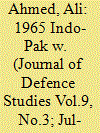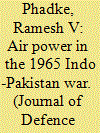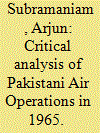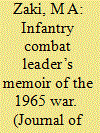| Srl | Item |
| 1 |
ID:
139185


|
|
|
|
|
| Summary/Abstract |
This article seeks to analyse the lessons of the 1965 Indo-Pak war that are applicable today. It finds that the current army doctrine, Cold Start, has some similarities to the opening round of the 1965 war. It argues that even the attritionist strategy adopted in 1965 may have more to give today than the manoeuvre war approach of its more famous successor, the 1971 war. In particular, the article appraises Prime Minister Lal Bahadur Shastri’s firm political control during the war and finds that it was ably reinforced by the prime ministers who were at the helm in India’s later wars. Knowing when to stop is key to avoiding nuclear thresholds, and in that the 1965 war, which stopped short of decisive victory, serves as a suitable precedent to potential future conflicts.
|
|
|
|
|
|
|
|
|
|
|
|
|
|
|
|
| 2 |
ID:
139184


|
|
|
|
|
| Summary/Abstract |
The 1965 Indo-Pak War came when India was in the midst of a major military expansion. India did not want to escalate matters when Pakistani forces invaded Kutch in April 1965 and accepted a ceasefire with British mediation. Although the government allowed the use of Indian Air Force (IAF) combat aircraft on 1 September 1965, action remained localised to the Chhamb area for five days. This was primarily because of India’s desire to avoid all-out war. IAF was used for counter air, air defence, and in support of the ground forces. Poor communications with the Army, lack of joint planning, an almost total absence of early warning and ground controlled interception (GCI) radars meant that its overall performance was sub-optimal. Despite these self-imposed restraints, India succeeded in thwarting Pakistan’s efforts to grab Jammu and Kashmir (J&K) by force, and to that extent the war did become a limited victory for India.
|
|
|
|
|
|
|
|
|
|
|
|
|
|
|
|
| 3 |
ID:
139183


|
|
|
|
|
| Summary/Abstract |
This article tracks the evolution of the Pakistan Air Force (PAF) into a potent fighting force by analysing the broad contours of joint operations and the air war between the Indian Air Force (IAF) and PAF in 1965. Led by aggressive commanders like Asghar Khan and Nur Khan, the PAF seized the initiative in the air on the evening of 6 September 1965 with a coordinated strike from Sargodha, Mauripur and Peshawar against four major Indian airfields, Adampur, Halwara, Pathankot and Jamnagar. The IAF riposte to PAF strikes came early next morning at dawn on 7 September. Over the next ten days, IAF surprised an overconfident PAF with its tenacity and individual combat proficiency. The article concludes by offering a critical analysis of the opeational performance of PAF in the conflict and an objective qualitative comparison with the performance of the IAF.
|
|
|
|
|
|
|
|
|
|
|
|
|
|
|
|
| 4 |
ID:
139186


|
|
|
|
|
| Summary/Abstract |
The article is a recall of the 1965 War by an infantry company commander in the war. It attempts to bring out how the war was conducted at the tactical level. Charlie Company, commanded by the author, was involved in several skirmishes, company and battalion level attacks as part of 19 Maratha Light Infantry. The unit was part of 7 Infantry Division and fought on the Punjab front. The article covers the run up to the war and the battles, bringing out the human element and tactical level aspects of conflict, some of which continue to be relevant 50 years on. It is a worm’s eye view of war, with an emphasis on combat leadership.
|
|
|
|
|
|
|
|
|
|
|
|
|
|
|
|